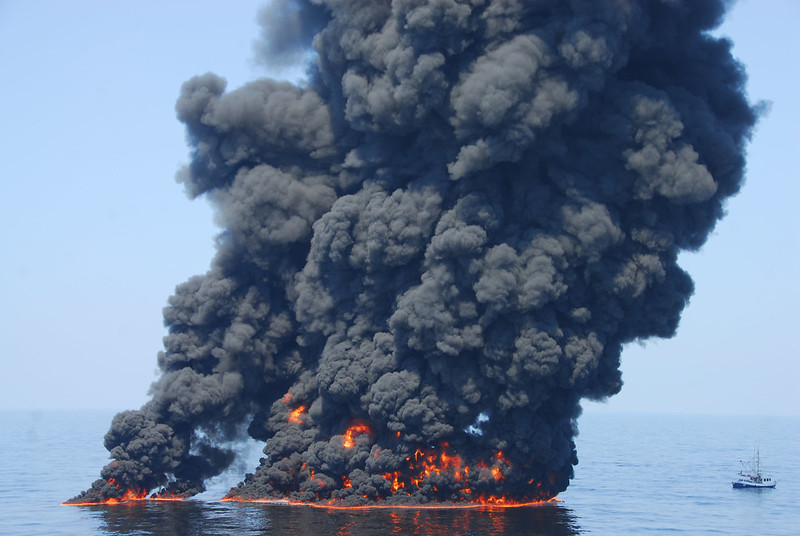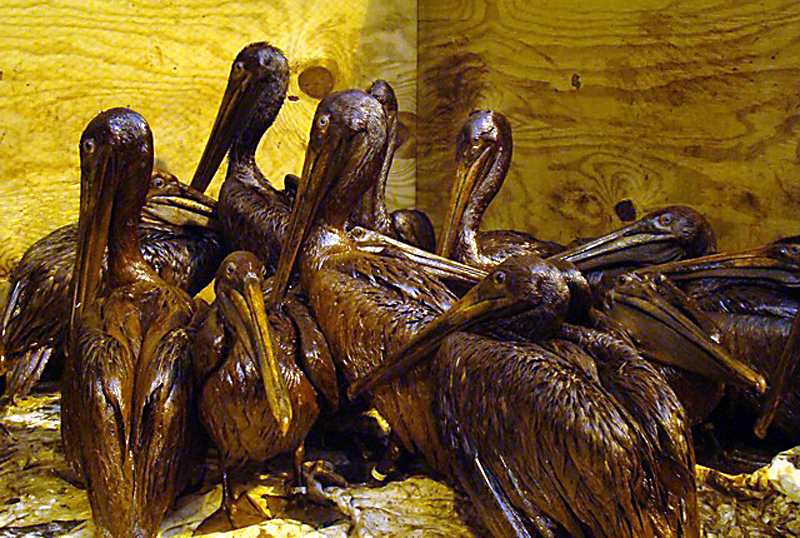Ten Years After the Deepwater Horizon Oil Spill, We’re on Course to Repeat One of Our Worst Mistakes
Tara Lohan

Editor’s Note: This story was originally published by The Revelator, a publication of the Center for Biological Diversity.
It’s been 10 years since flames engulfed the Deepwater Horizon drilling rig in the Gulf of Mexico, killing 11 workers and triggering the largest accidental oil spill in U.S. history. The resulting 168 million gallons of oil that spewed into the water for 87 days killed thousands of birds, turtles, dolphins, fish and other animals.
The messy slick washed up on 1,300 miles of beaches, coated wetlands with toxic chemicals, imperiled human health, crippled the region’s tourism sector and shut down fisheries — costing nearly $1 billion in losses to the seafood industry.
In the years since, scientists have studied the far-reaching and longstanding ecological damages. And it’s clear that problems persist.
A decade later, what have we learned? Are we any closer to preventing a similar — or worse — catastrophe? Here are some of the takeaways.
1. The spill was bigger than they told us.
Right from the start, industry downplayed the size and scope of the spill. The Unified Command formed to deal with the disaster consisted of officials from federal agencies, as well as representatives of BP — the oil company responsible for the mess.
Independent analysis using daily satellite images from NASA done by the conservation technology nonprofit SkyTruth, along with Ian R. MacDonald, a professor of oceanography at Florida State University, found that the amount of oil gushing from the failed Macondo well was likely 20 times greater than what officials were claiming at the time. Scientists hoping to measure the flow directly at the seafloor were blocked.
The obfuscation came with a big cost. “What followed was a series of under-engineered attempts to stop the flow of oil, wasting weeks of precious time as millions of gallons gushed into the Gulf,” recalls John Amos, president of SkyTruth.
2. Most other spills are bigger than reported, too.
Research in the Gulf of Mexico following the Deepwater Horizon disaster also led to other findings about drilling in the region. Not surprisingly, the size of most spills is underreported.
“This culture of misinformation doesn’t emerge just during catastrophes,” says Amos.
It turns out that slicks reported to the National Response Center were 13 times larger than provided estimates, according to research conducted by Florida State University and SkyTruth. And while companies can get in trouble for not reporting a spill, they don’t get penalized if they incorrectly estimate the size of a spill, the analysis found.
And these spills are ongoing, with more than 18,000 reported in the Gulf since the mammoth 2010 disaster. While many of them are small, their cumulative impact is not.
3. Deepwater Horizon isn’t the worst-case scenario.
A massive spill from a well that can’t be plugged for months is truly troubling, but there’s a worse scenario: a spill that can’t be stopped at all. And that slowly unfurling disaster has already been underway — it just wasn’t widely known until researchers began investigating the Deepwater Horizon spill.
A hurricane in 2004 triggered an underwater mudslide in Gulf waters that sank an oil-drilling platform owned by Taylor Energy. The mess of pipes, still connected to wells but covered by a heap of sediment, resulted in a leak that continues to this day.
A study by National Oceanic and Atmospheric Administration and Florida State University in 2019 determined that the wells may be spewing 380 to 4,500 gallons of oil a day — about 100 to 1,000 times more than the company has claimed.
After several attempts by Taylor Energy to cap the wells and contain the plumes didn’t do the trick, in 2019 the U.S. Coast Guard stepped in to have a containment system installed to catch the oil before it disperses into the waters.
4. Natural forces remain a threat.
A deep-sea mudslide like the one that damaged the Taylor Energy platform could pose a threat to dozens of production platforms in the Gulf. Florida State’s MacDonald, who has been studying the leaking Taylor Energy site, believes such an event could happen again.
Triggered by earthquakes or hurricanes, underwater avalanches of sediment slip down the continental shelf moved by “turbidity currents.” And we’re not well prepared for understanding how and when it could reoccur.
“Conducting studies to identify unstable slopes will improve our understanding of the seabed,” he wrote in an op-ed for The Conversation. “Better technology can make offshore infrastructure more durable, and informed regulation can make the offshore industry more vigilant.”
5. There’s no such thing as a “cleanup.”

A controlled burn of oil from the Deepwater Horizon/BP oil spill sends towers of fire hundreds of feet into the air over the Gulf of Mexico on June 9, 2010. (Photo by Coast Guard Petty Officer First Class John Masson / CC BY-ND 2.0)
Efforts that began in the aftermath of disaster should be termed “spill response,” and not “cleanup,” says Lois Epstein, an engineer and Arctic program director for The Wilderness Society.
Studies of previous spills have shown that oiled birds “cleaned” after spills usually fail to mate and suffer high mortality rates.
The use of booms, skimming, burning and the dumping of dispersants hasn’t proven effective in containing large spills — and seems to happen more to give the illusion that something’s being done, explains an article in Hakai Magazine.
During the Deepwater Horizon spill, only around 3% of the oil spilled was recovered from skimming, says Epstein. About 5% was burned off. And while dispersants decreased the volume of surface oil by about 20%, they increased the area over which the oil spread by nearly 50%.
Some advances have actually been made in improving the technology, but there’s “little incentive and no legal requirement for companies to upgrade their existing spill response equipment,” says Epstein.
6. The Problems Run Deep
Some of the most concerning findings from post-spill research came from the depths of the sea.
Research in 2017 found that, “the seafloor was unrecognizable from the healthy habitats in the deep Gulf of Mexico, marred by wreckage, physical upheaval and sediments covered in black, oily marine snow,” wrote Craig McClain, the executive director for the Louisiana Universities Marine Consortium, one of the scientists involved.
It’s likely that millions of gallons of oil ended up on the seafloor because of a process known as “marine oil snow” where chemicals from burning oil, along with dispersants and other sediment in the water, adhere and sink.
For life at the bottom, that dirty blizzard was incredibly harmful.
The researchers noted that animals normally found in that deep-sea environment, such as sea cucumbers, giant isopods, glass sponges and whip corals, weren’t there. And many colonies of deep-sea corals hadn’t recovered.
“What we observed was a homogenous wasteland, in great contrast to the rich heterogeneity of life seen in a healthy deep sea,” McClain explained. “In an ecosystem that measures longevity in centuries and millennia, the impact of 4 million barrels of oil continues to constitute a crisis of epic proportions.”
7. The effects on wildlife were both significant and, in some cases, sustained.

Heavily-oiled brown pelicans captured at Grand Isle, La. on June 3, 2010 wait to be cleaned of Gulf spill crude. (Photo: International Bird Rescue Research Center / CC BY 2.0)
The spill caused problems at the surface too, including the longest known marine mammal die-off in the Gulf of Mexico, and experts say it could take many species decades to recover.
For example, a report from Oceana found that in the five years following the spill, 75% of bottle-nosed dolphin pregnancies failed. Endangered Bryde’s whales lost 22% of their already small population; 32% of laughing gulls in the Gulf died, and as many as 20% of adult female Kemp’s ridley sea turtles, already critically endangered, were killed in the spill.
Threatened populations of gulf sturgeon exposed to the oil experienced immune system problems and damaged DNA. Scientists found skin lesions on tilefish, Southern Hake, red snapper and other fish in the area near the blowout for two years after the spill.
Coastal wetlands, critical habitat for numerous species as well as an important buffer against storms, were also damaged.
It’s believed that chemicals from the spill and dispersants have made their way from plankton up through the entire marine food chain.
8. The regulatory failure continues.
“There was nothing that happened with Deepwater Horizon that couldn’t have been foreseen,” says Mark Davis, a senior research fellow at Tulane University Law School and director of the Institute on Water Resources Law and Policy.
And that makes the policy and regulatory failures that enabled the disaster that much more painful.
In a 2012 study on the lessons learned from the disaster, Davis pointed to a long history in the Gulf of oil and gas development superseding risk assessment and planning. That was compounded by a cozy relationship between industry and its regulators in the Minerals Management Service.
“The federal government has a stake in the financial success of oil and gas development,” says Davis, and that doesn’t provide much incentive for strict regulation.
In the fallout from the disaster, the Minerals Management Service was disbanded and was replaced with the Bureau of Safety and Environmental Enforcement. But how much has really changed?
A story in E&E News found that problems still abound in the new agency and it’s “fractious, demoralized and riddled with staff distrust toward its leadership.
Davis said dissolving the Minerals Management Service was needed, but he’s not sure it’s achieved the needed improvements to regain public truth. The new agency “is still too focused on not being a burden to exploration and production to really be a guardian of public/worker safety and environmental health,” he says. And “until we get our policies and legal architecture in line with the risks we’re running, we’re going to be very vulnerable.”
9. Trump is making it worse.
Given the track record of the Trump administration on environmental policy, it should come as no surprise that the limited provisions made to improve safety and environmental health after the spill are being undone.
Last year the Interior Department changed its well-control rules to appease requests from industry. The rule change “reduces the frequency of tests to key equipment such as blowout preventers, which sit at the wellhead at the ocean floor and are the last-ditch defense against massive gushers,” explained Politico. “It also allows drillers to use third-party companies instead of government inspectors to check equipment and gives them more time between inspections, among other things.”
10. The Gulf of Mexico isn’t the only place at risk.
The ecological and human health imperatives for preventing another Deepwater Horizon — or worse — are important for Gulf communities and beyond.
In the past few years, the Trump administration has signaled that it wants to vastly expand offshore drilling, including lifting drilling bans in parts of the Arctic and Atlantic oceans. It’s a proposition that would lead to more spills and more greenhouse gas emissions at a time when it’s critical we reduce both.
His plan has been met with stiff opposition so far. But as the 10th anniversary of the Gulf disaster reminds us, we’re still on course to repeat one of our worst mistakes.
“The takeaway here is that people learn, but institutions react,” wrote Tulane’s Davis. “The Deepwater Horizon blowout may have taught many important lessons, but as yet, most of them are still unlearned by those most responsible.”







